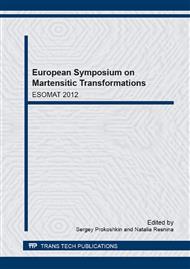[1]
T. Lookman, P. Littlewood, Nanoscale heterogeneity in functional materials, MRS Bull. 34 (2010) 822-831.
DOI: 10.1557/mrs2009.232
Google Scholar
[2]
L.E. Tanner, Diffraction contrast from elastic shear strains due to coherent phases, Philos. Mag. 14 (1966) 111-129.
Google Scholar
[3]
P. Lloveras et al., Precursor Nanoscale Textures in Ferroelastic Martensites, in: T. Kakeshita, et al. (Eds. ), Disorder and Strain-Induced Complexity in Functional Materials, Springer, Berlin 2012, pp.227-248, and references therein.
DOI: 10.1007/978-3-642-20943-7_12
Google Scholar
[4]
Y. Murakami et al., Precursor effects of martensitic transformations in Ti-based alloys studied by electron microscopy with energy filtering, J. Microscopy 203 (2001) 22- 33.
DOI: 10.1046/j.1365-2818.2001.00913.x
Google Scholar
[5]
Z. Zhang et al., Phase diagram of Ti50-xNi50+x, Crossover from martensite to strain glass, Phys. Rev. B 81 (2010) 224102.
Google Scholar
[6]
D. Wang et al., Strain Glass in Fe-doped Ti-Ni, Acta Mater. 58 (2010) 6202-6215.
Google Scholar
[7]
Y. Wang et al., Evidence for broken ergodicity in strain glass, Phys. Rev. Lett. 76 (2007) 132201.
Google Scholar
[8]
X. Ren et al., Ferroelastic nanostructures and nanoscale transitions: Ferroics with Point Defects, MRS Bull. 34 (2009) 838-846.
DOI: 10.1557/mrs2009.234
Google Scholar
[9]
T. Lookman et al., Ferroelastic dynamics and strain compatibility, Phys. Rev. B 67 (2003) 024114.
Google Scholar
[10]
K. Enami et al., Elastic softening and electron diffraction anomalies prior to the martensitic transformation in Ni-Al β1 alloy, Script. Metall. 10 (1976) 879-884.
DOI: 10.1016/0036-9748(76)90205-2
Google Scholar
[11]
X. Ren et al., A comparative study of elastic constants of Ti-Ni-based alloys prior to the martensitic transformation, Mat. Sci. Engng. 312 (2001) 196-206.
DOI: 10.1016/s0921-5093(00)01876-1
Google Scholar
[12]
J. Zhang et al., Elastic constants of Ti-48at%Ni-2at%Fe single crystal prior to B2®R transformation. Mat. Trans. JIM 40 (1999) 385-388.
DOI: 10.2320/matertrans1989.40.385
Google Scholar
[13]
S. Muto et al., Elastic softening and elastic strain energy consideration in the fcc-fct transformation in Fe-Pd alloys, Acta Metall. Mater. 38 (1990) 685-694.
DOI: 10.1016/0956-7151(90)90224-5
Google Scholar
[14]
Y. Zhou et al., High temperature strain glass in Ti50(Pd 50-xCrx) alloy and the associated shape memory effect and superelasticity, Appl. Phys. Lett. 95 (2009) 151906.
DOI: 10.1063/1.3249580
Google Scholar
[15]
E. Obradó et al., Order-disorder transitions of Cu-Al-Mn shape-memory alloys, Phys. Rev. B 58 (1998) 14245.
DOI: 10.1103/physrevb.58.14245
Google Scholar
[16]
Y. Zhou et al., Strain glass in doped Ti50(Ni50-xDx) (D=Co, Cr, Mn) alloys. Impliaction for the generality of strain glass in defect-containing ferroelastic systems, Acta Mater. 58 (2010) 5433-5442.
DOI: 10.1016/j.actamat.2010.06.019
Google Scholar


